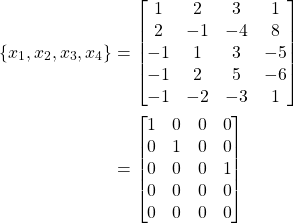Example:
(1) 
To prove linear independece, we need to prove
![]() when and only when
when and only when ![]()
By combining ![]() , we got this homogeneous equation and use Gaussian Elimination (both row deduction and column deduction is fine).
, we got this homogeneous equation and use Gaussian Elimination (both row deduction and column deduction is fine).
(2) 
Example:
(1) 
To prove linear independece, we need to prove
![]() when and only when
when and only when ![]()
By combining ![]() , we got this homogeneous equation and use Gaussian Elimination (both row deduction and column deduction is fine).
, we got this homogeneous equation and use Gaussian Elimination (both row deduction and column deduction is fine).
(2) 